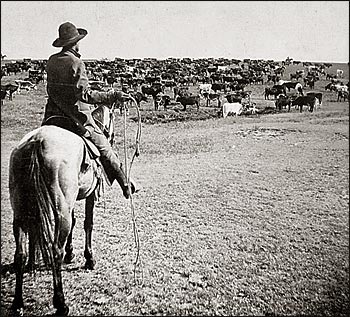
The Cattle Kingdom
In 1866, when the transcontinental railroad reached Abilene, Kansas, Chicago livestock buyer J.G. McCoy saw the possibilities of linking the unwanted herds of Texas longhorns with the meat-packing centers of Chicago. McCoy built a series of holding pens in Abilene and convinced south Texas ranchers to drive the cattle north along the Chisholm Trail to the railhead. In 1867, McCoy shipped 35,000 cattle to Chicago to end up on American dinner tables, and by 1871 this number had grown to 600,000. Abilene may have been the first cow town, but disease and rowdy cowboys shifted the cow capital first to Wichita, then to Dodge City, Kansas. The profits to be made were immense, with a $5 steer in Texas bringing up to $45 in Kansas. In fact, the profitability of the cattle kingdom was one of the factors contributing to its demise in 1886. Greedy ranchers dangerously overstocked the grasslands with cattle by the mid-1880s. Then, on January 1, 1886, a great blizzard buried the eastern and southern plains, killing 50 to 85 percent of the herds. The cattle industry survived, but in a very different form. The freewheeling cowboy of American legend became a ranch hand. Although the cattle kingdom lasted only a single generation, the romanticized cowboy remains an enduring symbol of Western America.
Image: National Archives




